Go Back
Blog: Exhibition Photo Shoot
Louis Wald
20/03/2012
The Wings of the Shechinah - The Sculptural Art of Herman Wald exhibition was photographed by Jac De Villiers. The photographs are reproduced in this blog accompanied by extracts from the wall text by Hayden Proud and Andrea Lewis describing different facets of the exhibition.
The scion of generations of rabbis, Herman Wald was born in 1906 in Cluj, Hungary. Growing to maturity in an increasingly anti-semitic Europe in the 1920s and 1930s, his restless journeys saw him moving from one artistic centre to another, successively studying in Budapest, Vienna, Berlin, and Paris. In 1933, when the Nazis came to power in Germany, he wisely left Paris for London. After four years of exposure to the work of British sculptors such as Henry Moore, Jacob Epstein and Frank Dobson, he eventually emigrated to South Africa in 1937.
Wald practised as a full-time sculptor in Johannesburg until his death in 1970. While the contributions of South African sculptors of Eastern European Jewish origin such as Lippy Lipshitz, Herbert Meyerowitz and Moses Kottler are acknowledged in the existing literature on South African art, Wald seems to have been denied little more than a passing mention. His work is also not represented in any of South Africa’s public art museums. It seems a cruel irony that while many of his public sculptures, such as his highly-popular Impala Fountain in Johannesburg (1959), are etched in the popular imagination, very few South Africans, even in informed artistic circles, know of his name.
The son of a rabbi, Wald was steeped in Judaism. As a professional sculptor, he spent his life interrogating and contesting the prescription of the Second Commandment: “Thou shalt not make unto thee a graven image, nor any manner of likeness, of any thing that is in heaven above, or that is in the earth beneath .” (Exodus 20: 5). With a heavy foreign accent Wald found South African society impenetrable, dependent as he was on commissions to survive. The local Jewish community was largely unsympathetic to sculpture for doctrinal reasons, and South Africans were mostly hostile to modern tastes in art. Wald was thus forced to adopt different styles and a variety of subjects to attract patrons and commissions. This was probably viewed by the “official” art establishment as symptomatic of a lack of artistic integrity.
Wings of the Shechinah: The Sculptural Art of Herman Wald celebrates the work of a sculptor whose finest works reflect the sublimity of Jewish spirituality as well as the calamity that befell European Jewry in the last century.
(1967), beaten copper 
These monumental copper wings once formed a part of Herman Wald’s ensemble design for the Aron Hakodesh (Holy Ark) of the Berea Synagogue in Johannesburg. His design consisted of these huge Wings of the Shechinah; the Ark itself made of dark marble; the Tablets of the Ten Commandments (also fashioned in copper) and a choir-screen of hanging chains made from bronze. The centrepiece of a then-new synagogue designed in a minimalist modern style, Wald’s Aron Hakodesh had a majestic and awe-inspiring presence. It was a superb example of his sculptural talents placed at the service of his religion; a religion that was fundamentally opposed to “graven images” because of the ruling of the Second Commandment.
The term Shechinah alludes to the fiery or luminous presence of the Almighty as referred to in the Hebrew Bible, which manifested as a burning bush [Exodus 14:20] and filled the holy of holies in the Temple of Solomon [1 Kings 8:10 and Chronicles 5:13].
In his synagogue-related work, Wald re-evoked an ancient tradition of artistic craftsmanship involving the use of beaten metal applied to core sculptural forms. We know that this was a tradition practised throughout the ancient world in the making of cult figures in temples, but within Judaism it particularly evokes the famous name of Bezalel, a craftsman chosen by God and charged by Moses to create the holy Ark of the Covenant itself. The latter, with its winged cherubim, is alluded to in Wald’s own Wings of the Shechinah, designed, as they were, to embrace the Ark in the Berea Synagogue.
In 1906, the very year of Herman Wald’s birth in Hungary, the Bezalel Academy, a major font in the renewal of Jewish visual and artistic traditions, was founded in Jerusalem. Today it is Israel’s national school of art.
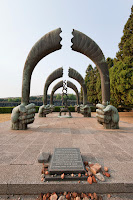

bronze - formerly Sandringham Gardens, Johannesburg

According to the Torah, one of the indispensible processes of Jewish mourning is the enactment of the Kria, the tearing of the outer garments by the bereaved. This bronze by the sculptor Herman Wald represents the suffering Prophet Job rending his own garments. Entitled Kria, this sculpture stood until recently in front of Sandringham Gardens, a Jewish Old Aged Home in Johannesburg. When the sculpture was first completed by Wald, it was fixed upon by the Johannesburg Jewish community as a suitable first monument to the Holocaust. In 1947 Kria was purchased from the artist and installed at Sandringham Gardens. A correspondent to the SA Jewish Times in 1949 was moved to write of it as follows: "Kria is a monument not to our dead, but to the survivors, a declaration that we live; an expression of sorrow at our bereavement, yet full of defiance". Wald was to follow this memorial with his impressive Monument to the Six Million (1959) which stands in Johannesburg's Westpark Cemetery. Here it forms a platform for the annual services held in memory of those who perished in the Shoah.
Monument to the Six Million (1959)
bronze - Westpark Cemetery, Johannesburg
 The most impressive of any of the memorials to the Holocaust in South Africa, Monument to the Six Million was also a significant feat of bronze casting and engineering. It was dedicated on the 10th of May 1959 by Rabbi M. Neurock, a member of the Israeli Knesset who travelled to Johannesburg for the occasion. Herman Wald articulated the symbolic intentions behind his design in a letter to London’s Studio Magazine as follows:
The most impressive of any of the memorials to the Holocaust in South Africa, Monument to the Six Million was also a significant feat of bronze casting and engineering. It was dedicated on the 10th of May 1959 by Rabbi M. Neurock, a member of the Israeli Knesset who travelled to Johannesburg for the occasion. Herman Wald articulated the symbolic intentions behind his design in a letter to London’s Studio Magazine as follows:
This monument depicts six mighty bronze fists, each five feet high, bursting out of the ground as a protest of the dead, each fist representing one million Jews who perished under Hitler, and each gripping a ram’s horn, the Jewish ritual trumpet, standing twenty feet high. In pairs they create three arches; the arches of trials and tribulations that the Jewish people have all gone through during all the generations of persecution. In the centre there is a flame-shaped Eternal Light, spiralling fifteen feet up. Through the ram’s horns the Dead are blasting out the Sixth Commandment: ‘Thou shalt not kill!’, while the centre eternal light is stylized through the medium of the Hebrew lettering, to form a flame which spells in Hebrew ‘Lo Tirtzach’ (thou Shalt Not Kill)’.
In 1977 enquiries about erecting a replica of the monument were received from Cleveland, Ohio, but nothing further materialised. Monument to the Six Million has become an iconic landmark for the Jewish community in South Africa. Each year the Holocaust remembrance ceremony attracts a very large crowd, with the base serving as the platform for the speakers and the choir. Wald and his wife Vera lie buried next to the monument, according to the artist’s last wishes.
Stampede: Impala Fountain in memory of Ernest Oppenheimer (1960)
bronze - Formerly on the corner of President and Joubert Streets, Johannesburg, where it was eventually vandalised. Since 2002 restored by Michael Wald and relocated outside the Anglo American Building, Main Street, Johannesburg.

Known variously as The Stampede or The Impala Fountain, this work is unquestionably one of the most popular public sculptures in South Africa. Like Wald’s earlier Monument to the Six Million (1959), it was another feat of engineering and bronze casting. When Alec Gorshel, a friend of Wald’s, became the Mayor of Johannesburg in 1959, he launched projects to improve the aesthetic environment of the city. He persuaded Harry Oppenheimer, head of De Beers and the Anglo American Corporation, to fund the erection of a public monument in memory of his late father, Ernest, who had died in 1957.
The decision to opt for a monument consisting of bronze impalas and a water feature was probably motivated by sentiments on the need to bring a sense of ‘nature’ back into the heavily-built urban environment where such animals had once roamed freely only decades before.
During the Renaissance in Europe, fountains had evolved into a major public art form. The necessity and availability of water for sustaining life made them ideal public symbols of good government. The use of fountain ‘set-pieces’ as expressions of confidence and civic pride, if not propaganda, was as relevant in Florence in the 1500s as it was in the dry, capitalist mining city of Johannesburg in the 1960s.
The success of Stampede led Wald to boast that it had been “unconditionally acclaimed by child or adult, by amateur or connoisseur” and that it was a work “unbound by time, fashion or ‘isms’”. Over the years, images of Stampede have been very widely published, so the general popularity of the work cannot be denied. However Wald’s own claim that it is a sculpture “unbound by time, fashion or ‘isms’ ” requires interrogation. Its soaring arc of bronze impalas evokes associations with earlier modern precedents that are the true progenitors of this work. The sequential photographs of Muybridge and the dynamism of Italian Futurist sculpture lie at the core of its populist heart. So too does the cinematic animation of such films as Walt Disney’s Fantasia (1940) and, most notably, Bambi (1942). The sculpture almost seems to reconcile two extremes in 20th-century culture that theorists like Clement Greenberg thought irreconcilable – avantgarde and kitsch. Wald was certainly not the first monumental sculptor of the 20th century to employ elements of the latter.
‘Unity is Strength’ Monument (1969)
bronze - Presently in the ABSA Building, Johannesburg
 This is a blunt, mechanistic vision of the human form that could have only been inspired by Wald’s earlier exposure to the modernist work of the English Vorticists, in particular Jacob Epstein’s sculpture entitled The Rock Drill (1913-1915). This sculpture was commissioned by the United Building Society in Johannesburg. According to Wald, it represented his vision for a future South Africa. Three men are represented joining their arms in communal effort, as he put it, “one with the face of a European, the second that of an African and the third the face of a man of mixed race origin”. It seems that a maquette existed for his work as early as 1962-1965.
This is a blunt, mechanistic vision of the human form that could have only been inspired by Wald’s earlier exposure to the modernist work of the English Vorticists, in particular Jacob Epstein’s sculpture entitled The Rock Drill (1913-1915). This sculpture was commissioned by the United Building Society in Johannesburg. According to Wald, it represented his vision for a future South Africa. Three men are represented joining their arms in communal effort, as he put it, “one with the face of a European, the second that of an African and the third the face of a man of mixed race origin”. It seems that a maquette existed for his work as early as 1962-1965.
The Diamond Diggers’ Fountain (1960)
bronze - Ernest Oppenheimer Memorial Garden, Kimberley
 This heroic five-figure fountain-ensemble was commissioned from Herman Wald to honour the men “who pioneered the diamond industry”. It was made for the Ernest Oppenheimer Memorial Gardens in Kimberley. The presence of such a fountain in the dry mining city was obviously intended as a symbol of hard work, economic success and good government.
This heroic five-figure fountain-ensemble was commissioned from Herman Wald to honour the men “who pioneered the diamond industry”. It was made for the Ernest Oppenheimer Memorial Gardens in Kimberley. The presence of such a fountain in the dry mining city was obviously intended as a symbol of hard work, economic success and good government.
The image of the “hero-worker” in this fountain was well-established sculptural rhetoric in Eastern-bloc countries like Hungary after some fell under Communist rule after World War I, when Herman Wald was still in his early teens. The doctrine of Socialist Realism which became the official style of all public sculptures in Soviet Russia under Stalin and epitomised by the gigantism of Vera Mukhina (1889-1953), set a trend that was emulated elsewhere. Mukhina’s huge Worker and Collective Farm Girl (1937) was seen on the Soviet Pavilion at the World Fair in Paris the same year that Wald departed for South Africa. If Wald did not see it, he must at least have been aware of it through the media. The idealisation of the worker was also a feature of euphoric socialist-inspired imagery in Israel after its foundation in 1948, as is reflected in Wald’s ceramic Chalutz Harvester (1953-1954). hile the rhetoric of Wald’s Diamond Diggers’ Fountain would appear to have its sources in official Eastern-bloc sculpture, the irony is that it celebrates the achievements of high-capitalism in South Africa’s diamond mines. The specific identity of the idealised workers represented is highly ambiguous; perhaps deliberately so. Do they represent the white pioneer miners or the many black workers without whose cheap labour the extraction of the diamonds from the depths of the Kimberley Hole would not have been economically viable?
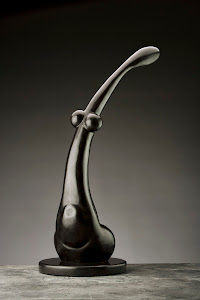

An Interpreter of the Body and its Mysteries
One of the defining traits of Wald’s sculpture is the diversity and the versatility of style and materials that he employed. The themes and content of his work are equally eclectic. While Wald was ostensibly a religious artist, his oeuvre also dealt with love, procreation, maternity, sexuality and the erotic. Much of it focuses on the human body, which he represents in fragments or combinations of figures. Through his representations of the body, he explored the sexual, intellectual and spiritual aspects of the human form. Considering the diverse influences of other artists on the young Wald as he travelled from one European city to another, it is hardly surprising that he interpreted the human body in diverse ways. He conveyed the beauty and expressive potential of the human form and used it repeatedly to communicate ideas and associations connected with it.
The ‘Ideology’ of the Nude
Like many artists before him, Wald used the human body to express a concept or an idea. Sir Kenneth Clark once claimed that “when art was once more concerned with the concepts rather than sensations, the nude was the first concept that came to mind”. He considered idealisation to be the quality of true nudes. This highlights an essential issue: as seductive and appealing as nudes in art may be, they are meant to stir the mind as well as the passions. According to Clark, the nude is ‘clothed in art’ and de-sexualised. It is often made to carry ideological meanings.
Sensuality and the Body
Wald explored the love motif through the human form. Many of his sculptures of the 1950s and 1960s are in bronze, fibreglass or plaster, representing sensuous male and female bodies represented as fragments or wholes, emerging from the material. In these highly-stylised works, Wald simplified shapes so that they became concepts rather than portraits; the figures are at once typical and casual, generalized and specific. Wald used these sculptures to grapple with emotions fundamental to interpersonal relationships; from passion and desire to love. His abstracted figure sculptures represent couples embracing or entwined; each possessing a sense of life and movement that seems to transcend the static nature of sculpture. The essence of his depiction of eroticism and sensuality lies in the open expression of the complexity of sexuality that admits of different interpretations of male and female eroticism. The liberating potential of the artist’s eroticism was based not only on the sensuality of male and female bodies, but, above all, on a vision of a pluralist sexuality.
Primitivism and Maternity
The female nude is often seen as germane to erotic art in the Western tradition; it is regarded not as a subject of art but as a form of art in itself. The female nude was not only an essential marker of modernism, it was often conflated with the notion of the ‘primitive’. The term ‘primitivism’ was used to describe non-European cultural artefacts from the Oceanic or African regions. Used more properly, it described the West’s obsession with ‘otherness’ rather than with the tribal artefacts themselves. European Modernist artists in the early 20th century were drawn to African or Oceanic sculpture because of its sophisticated approach to the abstraction of the human figure. The affinity between ‘primitive’ and modern sculpture thus pushed eroticism in a radical new direction, and there was often slippage between constructions of the ‘primitive’ and constructions of the female nude. In his Mother Earth (1946) or Returning to the Mother’s Womb (1950), which explores the maternity theme, Wald shaped the human form in a manner reminiscent of German Expressionist or British sculpture; both of which were influenced by non-Western art.
Symbolism and the Spiritualisation of the Body
Herman Wald considered himself a “symbolist”, and rejected the modernist notion that purity of form was the ultimate ambition of sculpture. The spiritualisation of the human form in his Weightlessness and Man and his Soul is evocative of Symbolism, a movement which flourished in Europe between 1886 and 1900 in almost every area of the arts. Symbolism was in large part a reaction against naturalism and realism – against the soulless urbanisation and materialism of the new industrial age. Where realists and naturalist artists sought to capture optical-objective reality, Symbolists sought a deeper authenticity from within the imagination, dreams and the unconscious. The Symbolists held that art should express more absolute truths which could be accessed only indirectly, preferring to roam the wider fields of mysticism, idealism, romanticism and obscurantism. The works here testify to Wald’s enduring fascination with the Symbolist potential of the human form. It is in this fluid style that he is probably at his most sensitive.
The Reclining Form of the Body
The concept of ‘reclining figure’ has appeared throughout the history of art, but it is also an elemental aspect of early modernist sculpture, especially with the work of Henry Moore (1898-1986) which was well-known to Wald. Moore began creating reclining figure pieces in the 1920s and continued with this theme throughout his long career. In the early 20th century, the reclining figure was seen to be much less restrictive, allowing an altogether richer, formal vocabulary, and was seen as an effective way to denote mourning, anguish and death. However, Wald, taking his cue from his Berlin teacher Totila Albert, tended to depict the reclining figures in a hovering or arched-back pose, as if to suggest that man should be striving for a higher spiritual plane.
The Abstraction of the Body
It was only near the end of his life that Wald allowed the modernist radical simplification of form to influence works such as his Torsos (1968) and La Femme (1969). Abstraction allowed him to blur the boundaries between gender and sexuality. In many of his abstract works, including those that one could term “Symbolist”, he fused male and female: these seeming to emerge and merge from one source and then part again. The presence of androgynous qualities suggests some of the ideas of Sigmund Freud that Wald may have absorbed. An androgynous figure is a person who is neither a woman nor a man, but rather something more desirable: an ‘other’ in romantic terms. When a man and a woman merge, it represents the possibility of a perfect being. Since Wald spent time in Vienna between 1928 and 1930 it is possible that he might have become aware of the work of Freud, who founded the discipline of psychoanalysis. Freud’s psychosexual theories conceived of a “third sex” in which masculine and feminine characteristics came together in a single body.


Wald and the “Primitive”
It has been speculated that when Wald was in Vienna, he saw the famous Stone Age sculpture, the Venus of Willendorf (24,000 BCE) at the Naturalhistoriches Museum there, and that this may have instilled in him a fascination for the “primitive” which was later seen in his African-inspired South African drawings and carvings, such as his totemic sculpture Mother and Child II (c.1946-1955). Like other European-trained sculptors, such as Mary Stainbank and Moses Kottler, Wald succumbed to a fascination with the African “exotic”. Like them, he had to adopt his carving style to suit the nature and limited scale of the local hard-woods available. It is further evident that, again like them, his ideas of the “African” and the “primitive” were more attuned to the formal qualities of Cubist and Expressionist work in Europe that had been inspired by African sculpture originating from West Africa, rather than anything truly South African. The highly-polished, flowing concavities of the face in Mother and Child III (1955-1965) are evidence of this, as are the simplified planes in his fantasy on Zulu life, The Zulu Protector (1968-1969) which was modelled and cast. The surfaces of Wald’s wooden South African “African” sculptures nevertheless reveal an enjoyment of the material. Wald exhibited in New York in 1952, where the influence of Africa on his work was explained as “the impact of primitive impulses of a primeval Africa upon the refined intellect of the European artist”, which in turn endowed his work with a “combination of earthy and spiritual completeness”.


In April 1959, Herman Wald held an exhibition at the New Queens Gallery in Johannesburg entitled The Bible as Sculpture. Supported by the Histadruth Ivrith, it was opened by Alec Gorshel, then mayor of Johannesburg. Wald gave a lecture on his own work which he prefaced with a reminder that he had sought to apply “these Biblical stories to our present-day happenings”. Besides discussing the various themes of each sculpture, Wald used his lecture to air his views on a number of related issues, ranging from the political to the theological. These seemed primarily aimed at the Jewish community rather than the official art world in South Africa.
The discussion of his sculptures of Moses inevitably brought up the issue of the Second Commandment. “The misinterpretation of this Commandment, rightly or wrongly”, Wald said, “was justified for the particular period when idol worship was the custom of the day; but when the danger of idol worship fell away, this Commandment as a defence was too high a price to pay to liquidate Jewish art from the midst of Jewry for all times .”.
Wald also took issue with the Jewish community for its hypocrisy: “As far as the other nine Commandments are concerned, I have yet a greater bone to pick with Jewry as a whole for the following reason: During my exhibition, a would-be buyer comes up to me, and excuses himself for not being able to purchase one of my sculptures because he was brought up in the orthodox Jewish atmosphere that he mustn’t, so I asked him and a multitude of others, “Tell me, do you keep all the other nine Commandments?” I never received an answer from any of them”.
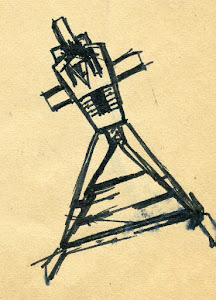
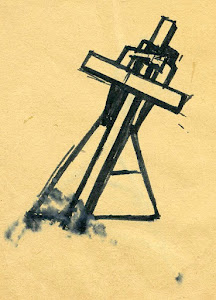
Making any representation of Christ was once taboo for Jewish artists, and various factors combined to make this so. The ruling of the Second Commandment was a primary one, as was the idea of making a portrayal of another historical Jew who had made claims to be “the Son of God”. Another factor was that for centuries Jews had suffered the calumny of being seen as his murderers. In the 20th century, however, this seems to have changed. For a notable number of 20th-century Jewish artists such as Marc Chagall, the suffering of Christ on the cross began to assume a greater and more generic significance, largely as a result of the Holocaust. Jewish and non-Jewish artists began to view it as a symbol of suffering in general – and of Jewish suffering in particular. The nakedness of Christ also paralleled the fact that most Holocaust victims were stripped before being gassed or shot.
When Chagall began to reference Christ’s crucifixion in the 1930s to symbolise Jewish suffering under the Nazis, many Jews found it disturbing. However, Chagall was making a point – he was representing the innocence of Jewish victims through the religious symbol of many of their oppressors.
Christ and the Crucifixion are referenced in a number of works by Herman Wald, none of which seem to have ever resulted in any major commissions for sculpture. Wald’s plaster Bust of Christ represented him as what someone termed a “tired old man; its lack of idealisation probably making it unappealing to potential Christian buyers. In Wald’s surviving drawings there are many that explore the possibilities of the subject of Christ carrying the cross as a vehicle for abstraction. Wald’s regard for the Cross as a powerful symbol is reflected in a few of his aphorisms, where he placed it on a par with the Ten Commandments as a “monument” that had endured for the singular reason that it was ultimately three-dimensional.
We also find evidence of other Christian subjects in Herman Wald’s work; as a full-time sculptor who needed to support his family in a predominantly Christian society, this should hardly come as a surprise. Wald’s interest in Biblical subject matter also made his work of great interest to Christian viewers.
On Memory and Loss: “The Crucifix of War”
Wald was profoundly affected by the outbreak of war after Germany’s invasion of Poland in September, 1939. Even before this, he had already had expressed his fears about a new war in sculptures like Gassed (1939); his warning on a return to the trench warfare of World War I (1914-1918). No doubt because he was of European Jewish origin and more attuned to the Nazi agenda, Wald became driven by the possibility of an even more destructive war. Interviewed in February of 1939, he stated that he believed that the most important thing he could do was “to use his art in the cause of peace”. It was noted of the artist that “always his preoccupation is with war, even in the peaceful Transvaal”.
Even before the War then, Wald attracted much attention with his anti-war work. This was especially so with his maquette for Monument to the Unknown Soldier (1938- 1939). Press articles said of him that he was “a pacifist, an idealist and a firm believer in the innate goodness of men . Indeed many of his latest works deal with the theme of war, its utter uselessness and horror. His very latest creation, his monument The Unknown Soldier portrays humanity crucified on the crucifix of war.” This image was much admired by many. Said one critic: “In black marble I cannot imagine a grander, more tragic concept of the glory and sorrow of death in battle. Herman Wald sees the mystery, the horror, the face and the irony of life in terms of classical tradition”. This large work, full of the rhetoric of a young artist in his 30s, never saw final realisation as a public memorial. It still survives as a plaster maquette.
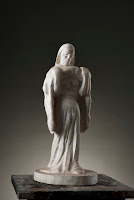

After South Africa also declared war on Germany in 1939, Wald enlisted in the Union Defence Force (UDF), where his talents were put to use. In 1944, for the “Liberty Cavalcade”, he made three giant uniformed figures in plaster representing the army, the air force and the navy. He also made a still-extant maquette for the UDF Corps of Engineers.
The motif of the Pietà – an image reminiscent of the Virgin Mary supporting the body of the dead Christ – appears in a number of Wald’s maquettes and drawings at this time, showing that, for a Jewish artist, he was drawing heavily on Christian iconography. The Pietà motif served on many war memorials commemorating the fallen, but it has to be said that in such instances it is not really a Pietà. The body of Christ is replaced by that of a soldier, and in place of the Virgin we find a female personification of the mourning “nation”. There is an underlying irony in such war memorials. The mourning mother is not only a mourner but also one of those who sent the now-dead soldier into battle.
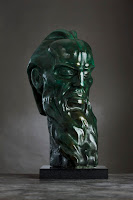
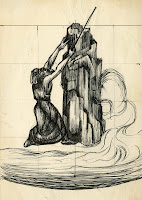
Moses dominated the life and work of Herman Wald, if for the simple reason that he was descended from seven generations of rabbis. By becoming a sculptor, it seemed to his rabbi-father that he was not only breaking the family “mould”, as it were, but also breaking with the fundaments of the Second Commandment. Moses and the latter thus became a focal point of an ongoing artistic polemic for Wald. In his Aphorisms and lectures, he was adept at pointing out some of the ironies and implications of the Second Commandment: “Moses I have a bone to pick with, and this is, he said, ‘Thou shalt not make any graven images’, and with the same breath he took a chisel and carved it into stone . had he realised that he had signed the death sentence at the same time to the existence of Jewish sculpture, he would have thought twice”.
Going even further than this he wrote: “The worst or tragic result of this is, if I may put it that way, that this Commandment has been detrimental to Jewish art to such an extent that it deprived Jewry of the most elementary form of expression.” These strident views were more tempered by age and experience when he later stated: “Though the religious environment into which I was born seemed to clash with my calling, later when I discovered that religion and art do not ultimately exclude each other, but go hand in hand, my mind was at peace and I accepted the calling”.
Moses was a favourite theme in Wald’s sculpture, as one can see from archival photographs, and his passion in portraying him was recognised by critics . “The portrayal of Moses on the Mount” wrote one, “is charged with all of the vigour, the strength and burning ardour of the Old Testament (The Union Review, October 1944). One senses in these figures, with their strident movement and somewhat histrionic poses, something of the influence and tempo of the cinematic. Wald must have been familiar with the populist image of Moses in Cecil B. De Mille’s epic-scale films of The Ten Commandments, a black and white silent film of 1923, and a widescreen remake with Charlton Heston released in 1956.
Significantly, for Wald, the Ten Commandments was always conceived of as a carved “monument”, and Moses its original “sculptor”.
Sanctum choir screen (c.1950-1951)
carved kiaat wood in sections Formerly in the Springs Synagogue, Springs
Sanctum was Wald’s first commission for a sculptural fixture in a synagogue. He was sad that his late Rabbi-father had not been alive to witness this auspicious moment in his career as the latter had always questioned his calling as a sculptor. The commission recalled Wald’s own experiences singing behind synagogue screens in his youth. In this commission he had attained the honour of carving the front of one.
The iconography of Sanctum seems a clear statement of Zionist triumphalism, as the state of Israel had been declared in 1948, only a few years earlier. The great seven-branched Menorah candlestick, symbol of the new State, dominates; centralised as if a symbolic apotheosis of Israel itself. The Menorah was quoted, as Wald himself said, “from the time of Titus the Conqueror”, a reference to the famous relief carving of it on the Arch of Titus (Rome, 81 CE). Here for centuries, it has been represented, much to the humiliation of the Jewish people, being carried off as Roman loot after the Sack of Jerusalem in 70 CE. Its centrality in Sanctum can be interpreted as symbolising its restoration after the 1948 triumph of the Zionist enterprise.
Situated at the base of the Menorah, the Ten Commandments flanked by the Lions of Judah from what Wald saw as the symbolic “foundation” of the whole work. Hands offer prayer in the orthodox Chassidic manner, and the flying draperies at the edges were interpreted as “the tallis which symbolises the four corners of the world”. The hands bearing the Lulaf (bound branches) from the Festival of Sukkot, as Wald indicated, “give the impression of lighting the Menorah with the flame of their devotion”. The whole composition seems redolent of the visual rhetoric of Art Deco that was a feature of official art in the 1920s and 30s.


Some Thoughts on the Portrait Bust
Portrait busts are startlingly ‘real’ and yet on another level wholly artificial. While we have internalised the concept of the “bust” as it has been passed down to us since the Romans, other have viewed it as a bizarre object of disgust. The Greeks thought the Romans wholly barbaric because they admired representations of heads “severed” from bodies. While we admire busts for their realism, they are, unless painted, always monochromatic and true to the colour of their material. There is a poignancy to most of them. Commissioned to immortalise the living, they almost always end up as cumbersome reminders of an unimportant person long dead. Unless endowed with superior qualities through the talent of the artist, or the surviving fame of the sitter, most busts become, despite their intended permanence, irrelevant. This collection of images of busts by Herman Wald gives some idea of his range as a portrait sculptor. At the same time, it highlights a world of personalities and a social milieu that has now vanished.
The Work of a Portrait Sculptor
Wald never had a full-time teaching post, and as a family man he had to seek commissions in order to survive. Portraiture was a potential source of income. Official commissions were scarce, so he had to depend on his social connections with many organisations, such as the theatre world, for work in this area.
South African clients, uneducated about modern art, had a primary expectation of realism. It was only with highly-educated sitters, such as the visiting author Cecil Roth, that Wald was able to use a modernist simplification of form. Many casts were later made of Roth’s bust and it was viewed as a success in his own circles. Wald always ran the risk of offending his clients unintentionally. The Oppenheimers were unimpressed with his bust of Sir Ernest Oppenheimer because it looked “too Jewish”, and another had to be made that met their view of themselves.
Many successful child portraits were also made by Wald, possibly because he was always at ease with children. It was the sentiment and satisfaction of the parents, not the child sitters, that always determined final acceptance of his work.
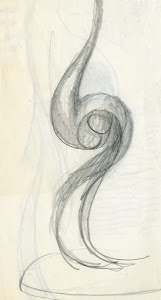

In 1940, three years after arriving in South Africa, Wald held a solo exhibition of drawings in East London, where his brother Marcus was rabbi to the Jewish community. Mounted at the Howard Shaw Gallery, it was billed in the local press as a “show of modern drawings … that fit in with a new age”. No drawings from this show have yet been found. One of them was entitled Sacrifice, which local critics praised as a “masterpiece of composition and characterisation”. With its theme of a mother sacrificing her son to war, it obviously aroused much sympathy and interest because of the War.
Many drawings by Wald have survived, but it is clear that these were never intended, unlike the lost East London drawings, for exhibition as “finished” works of art. Wald’s drawings mostly took the form of rough sketches made while articulating and exploring his sculptural ideas. To many eyes these drawings may appear at first to be trivial doodles or vague palimpsests. A sculptor’s drawings, by their very nature, can be, as W. J. Strachan has noted, “the most abstract, the most sophisticated and the least accessible to the uninitiated”. Essentially such drawings are about fleeting ideas and shifting concepts; sometimes wholly unconcerned with accurate observation or “correctness”. It also has to be noted that sculptors also place an emphasis on preliminary “sketch models” in clay or plaster in combination with their explorations through drawing.
This wall presents a small selection from Wald’s extensive corpus of drawings in relation to various projects and themes that interested him as a sculptor. Further drawings are to be found displayed in speculative contexts throughout this exhibition.


Wald grew up in an affluent Jewish and highly-observant home in Cluj, Hungary, surrounded by Jews from diverse backgrounds and religious traditions. This is the kind of cultural atmosphere that he captured in these genre figures. They are rendered with humour, affection and expressive power. Their features are realistic portrayals of Jewish characters: monumental despite their scale. Making these figures was therapeutic for the sculptor.
By bringing this lost world to life, Wald reminisced about his lost childhood in Hungary, conjuring the atmosphere of a rich culture wiped out by the Holocaust. Clad in their distinctive clothes, these Jewish characters argue, debate, and gesticulate to make their point. They dance and sing or share a pinch of snuff, and at times the kiddush wine has put them on a higher plane of happy abandon. They are based on the rich reservoir of Ashkenazic folk art found in 19th-century ceramics; on humorous Rosh Hashanah greeting cards, or on characters from the Yiddish theatre.
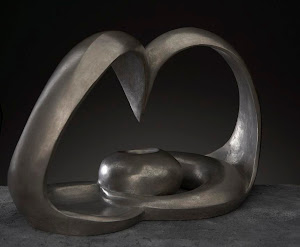

In 1968 and 1969, little realising that he did not have long to live, Herman Wald privately abandoned figuration and produced a series of enigmatic sculptures. Birth of an Idea (1968), Hunger (1968), Têtê à Têtê (1968) and Conquest (1968) alll promised startling new departures in his work. These were mostly made using new techniques of casting in ceramic, using clay slip in a plaster mould, as well as working with fibreglass resin. Only Conquest was realised in bronze. The content of these works is open to interpretation on many subjective levels, but most importantly they continue to explore the possibilities of symbolic form, rather than form purely for its own sake. The results show his powers of organic abstraction. In these final works, Wald approximates Constantin Brancusi’s radical reduction purification of form in order to attain a metaphysical essence.